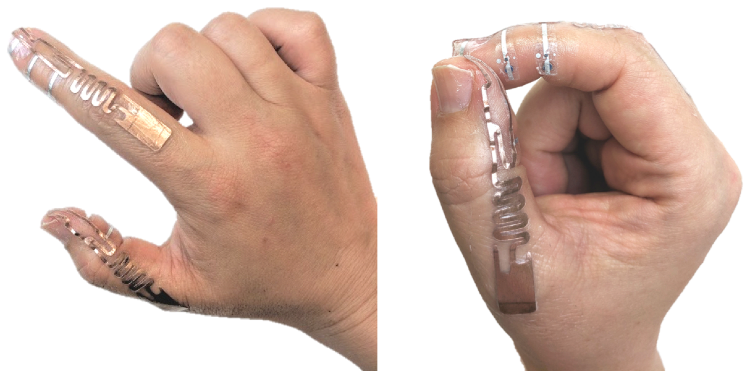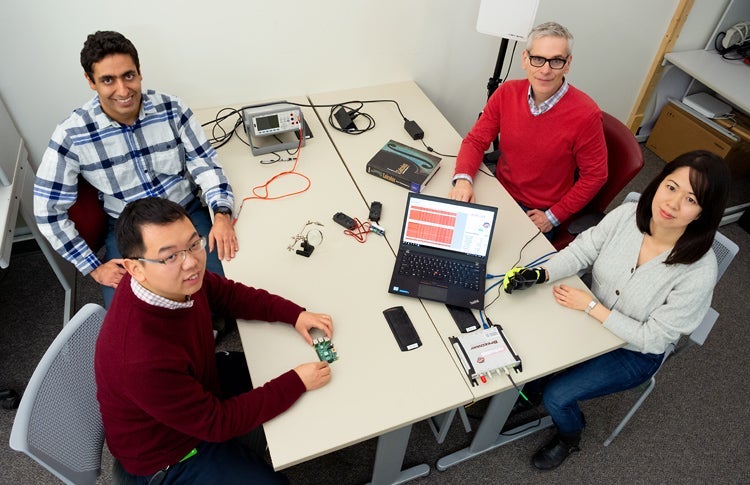Researchers at the David R. Cheriton Cheriton School of Computer Science have created a device for wearable computer input suitable for many situations, just by touching your fingertips together in different ways.
Called Tip-Tap, the device is inexpensive and battery-free because it uses radio frequency identification (RFID) tags to sense when fingertips touch. The device could be added to disposable surgical gloves, allowing surgeons to access preoperative planning diagrams in an operating room.

The
RFID-based
Tip-Tap
device
attached
to
a
person’s
hand
as
an
on-skin
electronic
tattoo.
Each
contact
array
has
three
RFID
chips
connected
to
a
copper
tape
half-antenna
shaped
like
half
of
an
RFID
tag. Tip-Tap
is
designed
to
sense
when
two
fingers
are
touching,
allowing
someone
to
control
a
finger
while
doing
something
else.
“One of the many possible applications of the device is in surgeries. What typically happens now with operation digital preplanning is that an assistant is responsible for navigating the computer and communicating with the surgeon, but this is slow and difficult,” said Daniel Vogel, a professor in Waterloo’s David R. Cheriton School of Computer Science. “If the surgeon tries to navigate it themselves using a touchscreen or a mouse, it’s problematic because it would require constant sterilization, and current alternatives such as big gestures tracked by computer vision can get very tiring.

Clockwise
from
bottom
left:
Postdoctoral
fellow
Ju
Wang,
Professors
Omid
Abari, Daniel
Vogel
and
Keiko
Katsuragawa.
Professor
Katsuragawa demonstrates the RFID
Tip-Tap
device
on
a
glove
with
smooth
pads.
When
pressing
the thumb
and
index
contacts
together
two
RFID
chips
are
connected
in
series and
two
flexible
core
wires
work
as
a
single
dipole
antenna.
The
radio signal
from
the
tags
is
received
by
the
white
reader
behind
Professor
Vogel.
“The idea is if you mount Tip-Tap in surgical gloves, surgeons could navigate the computer themselves from where they are, and it won’t affect their other actions like picking up the scalpel.”
Researchers created the prototype of Tip-Tap as part of a new partnership with the National Research Council of Canada.
In developing the method, the researchers mapped the most comfortable areas on the index finger for people to touch with their thumb, and tested different designs for the input points, such as smooth, bumps or magnets. Following user tests with an early wired prototype to benchmark performance, they tackled the problem of making it battery-free.
The researchers were able to make Tip-Tap battery-free by splitting the antenna of an RFID tag in two, and equipping each side with three chips to enable two-dimensions of fingertip input, the first time this had ever been done.
The new RFID tag can be integrated into a glove or attached directly on the skin as a temporary tattoo.
“We used this design in two prototype Tip-Tap devices — a glove with a range of four metres and an on-skin tattoo,” said Professor Vogel. “Such devices are useful for issuing simple commands when a user cannot easily hold an input device, and the usage context is a defined area — for example, factory workers, surgeons, or people exercising in a gym.
“This is the only device of its kind that we’re aware of that doesn’t require a battery or cumbersome wires to make it work.”
This research in the news
- Read “Introducing ‘Tip-Tap’ Waterloo’s new sci-fi tech for surgeons,” an article about this research, which was featured on CBC News, Kitchener-Waterloo on December 1, 2019.
- Watch “UW tech could help surgeons,” an interview on CTV News Kitchener, which aired on December 1, 2019.
The study, Tip-Tap: Battery-free Discrete 2D Fingertip Input, was conducted by Keiko Katsuragawa, Ju Wang, Ziyang Shan, Ningshan Ouyang, Omid Abari and Daniel Vogel from the Cheriton School of Compute Science. Keiko Katsuragawa is also a research officer at the National Research Council.
The study was presented recently at UIST 2019, the 32nd ACM User Interface Software and Technology Symposium in New Orleans, Louisiana. The ACM Symposium on User Interface Software and Technology (UIST) is the premier forum for innovations in human-computer interfaces.